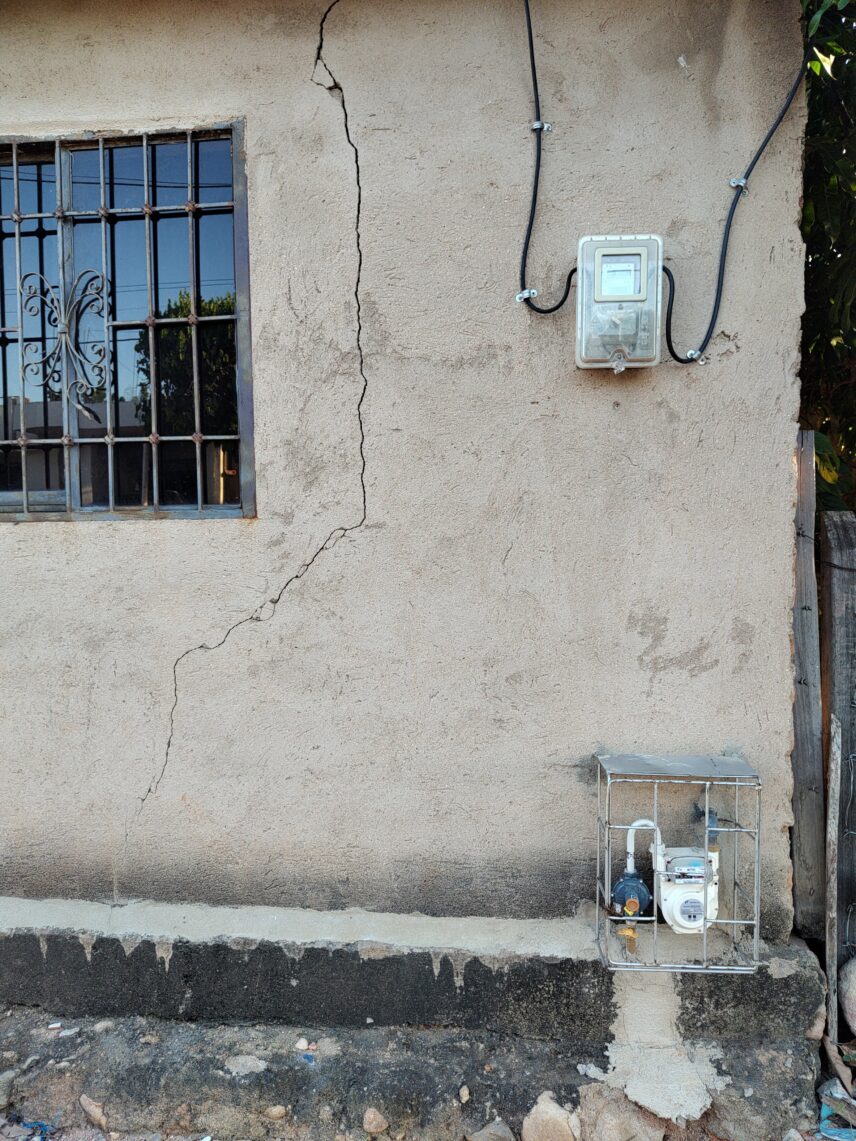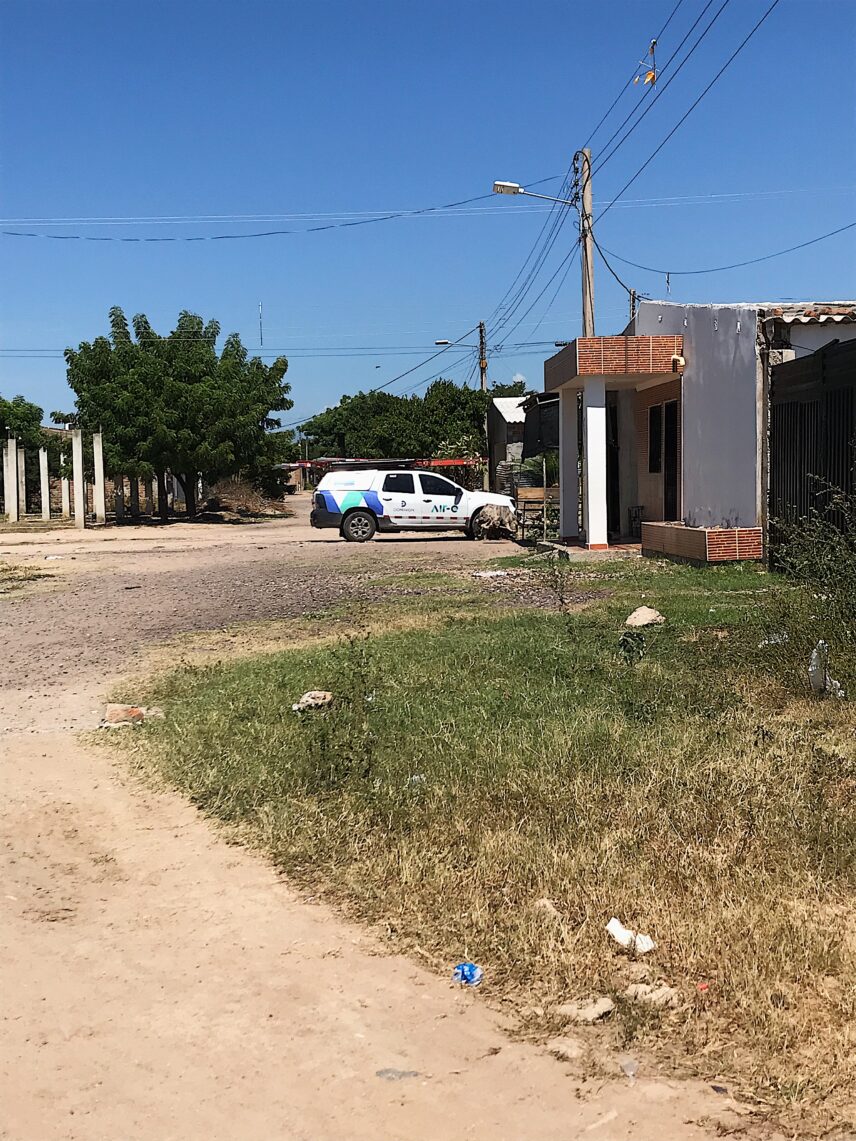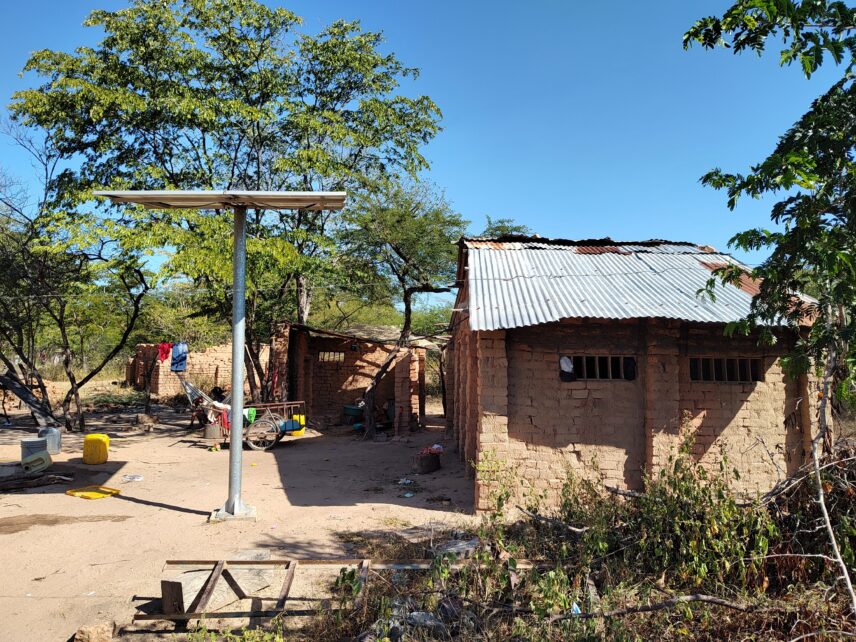Article begins
“Could you imagine heat like this without a fan?,” people in San Juan del Cesar ask rhetorically, while sweating. As a municipality in the southern part of La Guajira, Colombia, San Juan del Cesar is one of the sunniest and hottest places in the tropical country, with temperatures that exceed 30°C (86°F) every day of the year. The sky in San Juan del Cesar is clear during most of the daylight hours, so objects seem to melt in the constant light; fresh air from a sporadic breeze always feels like a blessing. Between San Juan del Cesar’s leaden sun and hot Caribbean air, electricity is paramount, and fans are everyday necessities, not luxuries.
This combination creates a perfect pressure cooker, so urban activists in the municipality are locked in a battle with Air-e (literally “air,” but with an inconsequential hyphen), the electric utility company. They organize demonstrations in public spaces, where they use baseball bats to hit the air around them and set fire to electricity bills. They stage sit-ins at the company’s offices to demand lower tariffs, reject the installation of “smart” meters, and claim that Air-e has not provided appropriate electric infrastructure despite constant requests. Even nonactivists in San Juan del Cesar resist in their own ways. Some inhabitants of the so-called subnormal neighborhoods have constructed their own energy infrastructure using tree trunks, while others have connected illegally to the electric grid so that they can power their televisions, computers, cell phones, refrigerators, and, most importantly, fans. At the end of the month, they refuse to pay their bills; nonpayment is also part of the protest.

Las Tunas 2 is one of those “subnormal” neighborhoods on the outskirts of San Juan del Cesar. Many of its residents are poor and its roads are unpaved, so sand rises into the air every time a moto-taxi drives through. Most houses are built by the inhabitants, including the home of one of its leaders. With an average temperature around 38°C (100°F), the front yard of his house is the coolest because a roof blocks the sun; there is space to sit and talk in Rimax plastic chairs. In this same front yard is an Air-e smart meter, which the company installed even though his house is not connected to the local distribution system. To have electricity, the neighborhood leader had to cut down a tree, put it at the corner of the street, and connect wires he bought. Now, his energy bill arrives printed in red ink because the company sees him as a defaulter, since he has accumulated a large debt—but the heat is high and his family needs cool air from a fan, even though they can’t afford the bill.
Across the municipality and the country at large, there are many similar situations, and the dynamics of energy infrastructure in the Caribbean have a long and fraught history. The previous energy utility company, ElectriCaribe, went bankrupt and finally shut down—but only after constant cuts and high bills, not to mention loose wires in the streets that often caused deaths. In 2020, Air-e came into the picture, but the problems have only worsened. People must still fight for fair billing rates, even as the heat intensifies because of climate change, harsher El Niño periods, building materials that raise temperatures, and new construction that removes shade-providing trees, all of which require fans, refrigerators, and—the ultimate dream—an air-conditioning unit.
Here, the heat is not just a matter of temperature. In Colombia, they say that an area is caliente (hot) when it is dangerously violent and when there is the presence of paramilitary groups and guerrillas. San Juan del Cesar was certainly caliente, and one of the zones most affected by armed conflict. In the 1980s, the Ejército de Liberación Nacional (ELN) and the Fuerzas Armadas Revolucionarias de Colombia – Ejército del Pueblo (FARC-EP) patrolled part of the municipality. At the beginning of the 2000s, Guamachal, one of its rural villages, became the center of operations of the Northern Block of the AUC (Autodefensas Unidas de Colombia). Stories of disappearances, massacres, extortions, and kidnappings are part of the municipality’s memory. The process was fueled by a chain reaction initiated by land-grabbing, partially because the municipality has such an enviable geostrategic position, in the valley of the Cesar’s River between the Sierra Nevada de Santa Marta and the Serranía del Perijá. Close to the border with Venezuela, San Juan del Cesar has a long agricultural—specifically pastoral farming—tradition. Now, in addition to the barbed wire, guerrilla resistance to land encroachment, and rising rental rates that made it metaphorically caliente, its literal heat is making it Colombia’s energy frontier.
The collusion of thermodynamic and social heat makes this region a promising territory for advancing the “just energy transition” in the country. On one hand, according to Institute of Hydrology, Meteorology, and Environmental Studies maps, this area has excellent solar radiation throughout the year, making it perfect for developing renewable energy projects, especially solar power. Conversely, its violent past and existing landownership structure make it attractive for private companies seeking to install solar and wind farms on private land (mostly former terratenientes (landowners with big extensions of land), where they are negotiating with socioeconomically disadvantaged rural residents.

Take the example of Guamachal, a rural community of San Juan where all energy transition projects meet: a future solar farm, multiple high-voltage lines, and an electric substation. It was also the place from which paramilitary groups in the region operated. “We live here in an enredero [entanglement], and we are at the center of it,” said Rafael, one of Guamachal’s leaders, as we navigated the rural area under high-voltage cables, foundations of future towers, and plots in which solar panels will be installed. He also used the word “enredero”to designate the cumbersome information and negotiation meetings with electric companies and their constant excuses for not repairing roads or executing the “social investment” they promised. The hassle is worth it, Rafael said, because there are jobs, occasional gifts (shirts, toys for kids, furniture for the primary school), and hope that there will be opportunities to improve the road. But there is also a deep sense of unfairness because the projects will not bring cheaper electricity: “We are poor, victims of the conflict, a rural population; there is no way we can afford the bills,” said Rafael, citing one case of an elderly woman living alone with nothing but a fan, a couple of light bulbs, and no refrigerator.
Likewise, in La Esperanza, another of San Juan’s urban areas, one of the people leading the protests against Air-e told us, “We don’t have [electric] networks. We have telarañas [spiderwebs] because we are subnormal neighborhoods.” These informal grid connections feed long-standing conflict with Air-e. A woman in that neighborhood, herself displaced by paramilitary groups from Magdalena (a neighboring department) after they killed her partner and brother, said to us, “Of course, we plug ourselves to the grid: do you know what it means to sleep in the heat?” Air-e’s response, one of the protest leaders told us, was to install “smart meters” that, he complained, “keep measuring when there is no electricity, are installed in inaccessible places, and can be read from a distance, from Barranquilla [a capital city a few hundred kilometers away].”
As these two neighborhood leaders navigated undesirable entanglements, new schemes emerged to cool down the conflict. Air-e intends to normalize “subnormal energy” through payment plans to write off the debts. At the same time, the new left-leaning national government under President Gustavo Petro is proposing “energy community enterprises” to provide solar panels to urban houses. Rural areas have gotten solar panels because San Juan is among those territories prioritized for rural development in the aftermath of the 2017 peace agreement with FARC-EP, the largest and oldest guerrilla group in the country. But all of these strategies replicate state-making practices that made the region caliente in the first place. One of the protest group leaders told us, “They want us to charge people with a bill for the maintenance of the equipment; imagine that, now I’ll do the bills, madness.” A state contractor already charged “maintenance bills” for the solar panels installed as part of the post-peace-agreement development of rural households. In the meantime, energy projects systematically reject giving rural and urban communities cheap electricity, reasoning that they do not “distribute” energy, citing the laws that structure the energy system in Colombia as if this were a fact of nature.
Meanwhile, turning solar brightness into electricity remains central to fantasies of a different life. Some residents dream of being able to afford a regular cold breeze from a fan, cold drinking water, and cold food from a refrigerator. Then there are dreams of charging a phone, watching TV, or even having an air-conditioning unit. Beyond that, some dream of the chance of growing their own food and caring for animals (and their own families) by being able to keep chickens alive—they normally die of heart attacks in the extreme heat—not to mention having a stable job with one of the new solar energy companies. But the most common dream of all? To disconnect entirely from the grid, which looms as a figure that excludes them, hoarding their energy.

“Energy transition for life” is one of President Gustavo Petro’s premises (and promises), and he has emphasized that the transition needs to happen without excluding any community or nation; he says that projects must benefit the inhabitants of historically excluded territories. However, the political discourse around “just energy transition” hasn’t reflected that heat is a topic with different facets of justice; a particular moral economy influenced by extreme heat and deep wounds in San Juan de Cesar is where these ethics and politics are still taking shape.
Energy transition on this frontier demands that we think about justice in broader terms—like reparations to people who, amid extreme heat, have had to live through violence and who now live the legacy of the conflict. To create a just energy transition, Colombia must acknowledge heat—in all its senses—as part of the entanglements replicating injustice throughout its territories.

